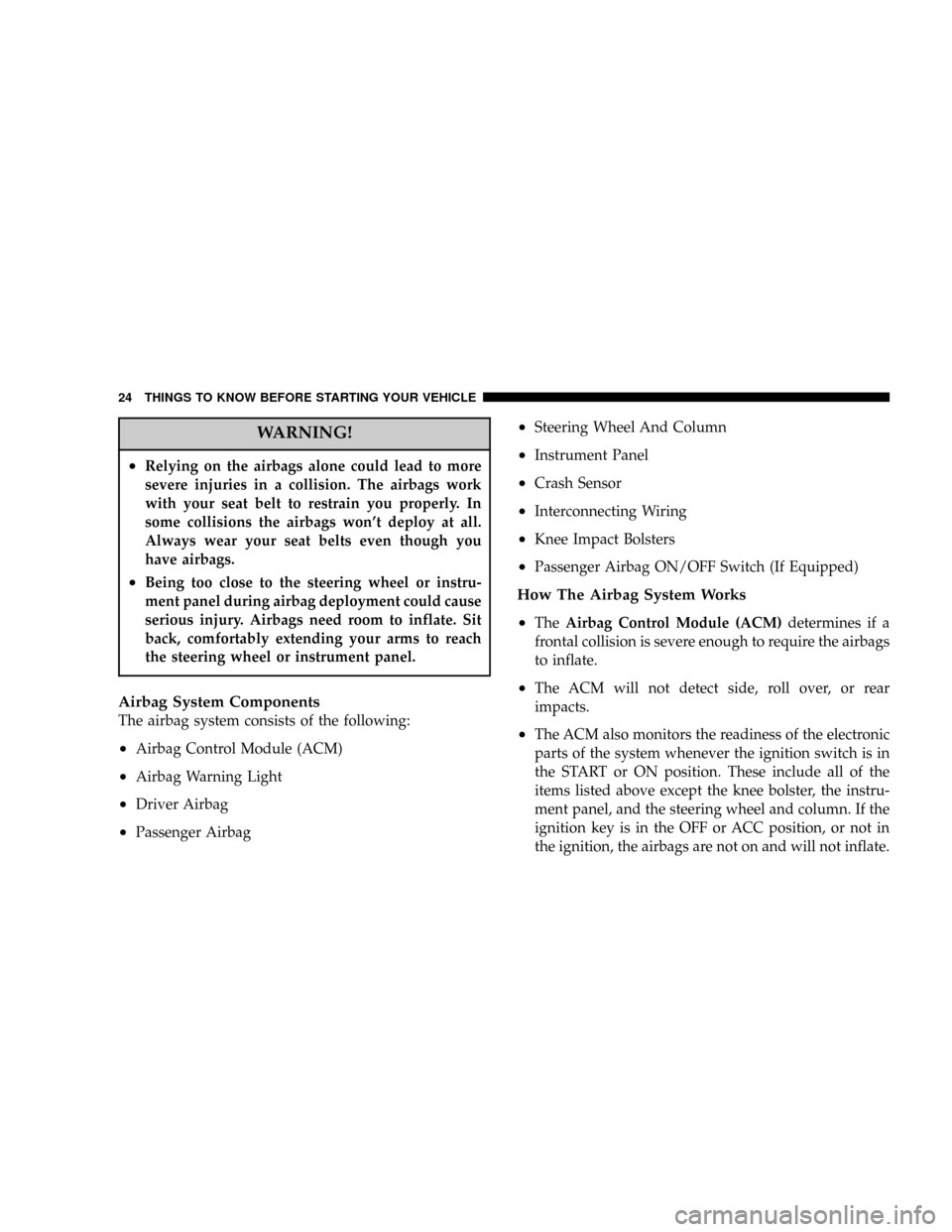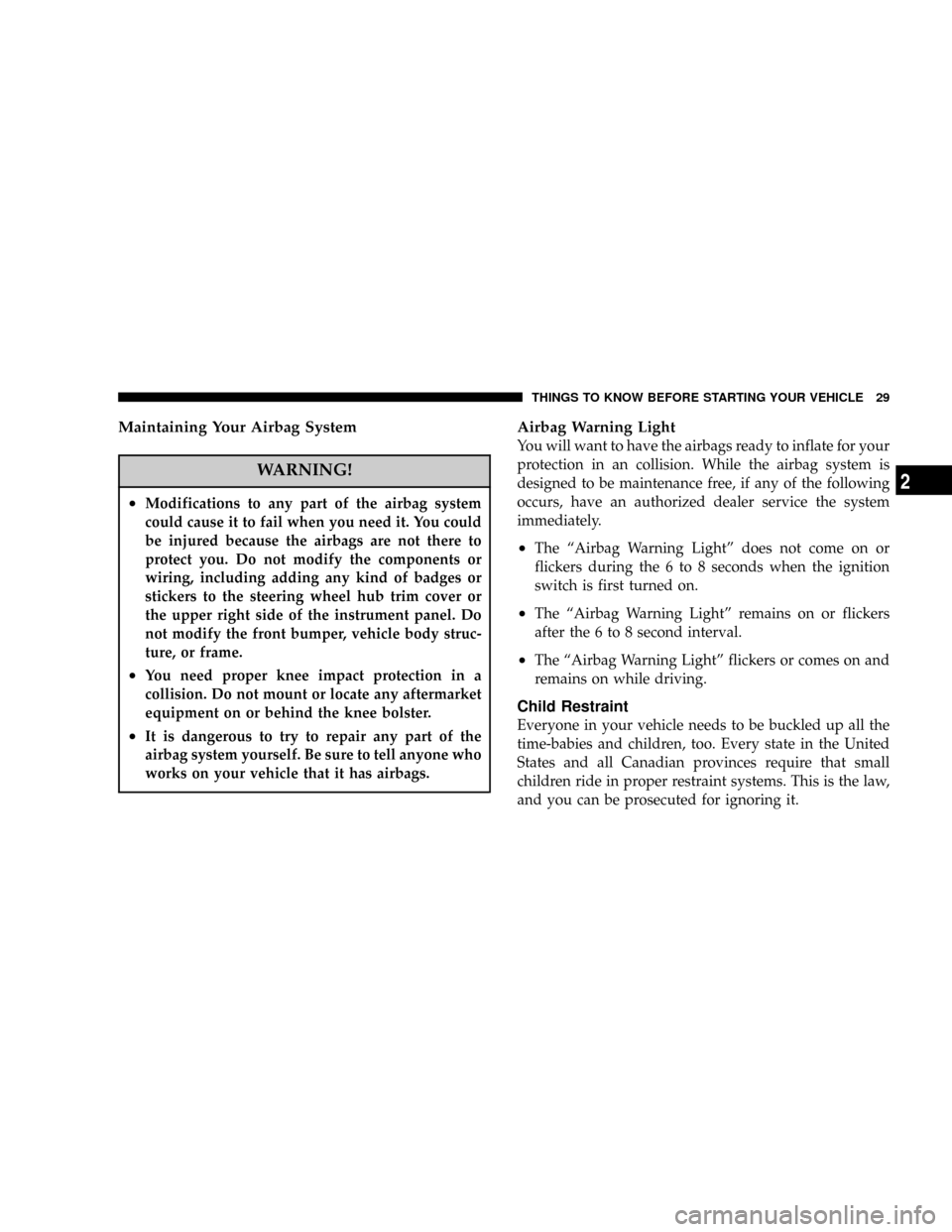wiring JEEP WRANGLER 2004 TJ / 2.G Owners Manual
[x] Cancel search | Manufacturer: JEEP, Model Year: 2004, Model line: WRANGLER, Model: JEEP WRANGLER 2004 TJ / 2.GPages: 299, PDF Size: 6.82 MB
Page 24 of 299

WARNING!
²Relying on the airbags alone could lead to more
severe injuries in a collision. The airbags work
with your seat belt to restrain you properly. In
some collisions the airbags won't deploy at all.
Always wear your seat belts even though you
have airbags.
²Being too close to the steering wheel or instru-
ment panel during airbag deployment could cause
serious injury. Airbags need room to inflate. Sit
back, comfortably extending your arms to reach
the steering wheel or instrument panel.
Airbag System Components
The airbag system consists of the following:
²Airbag Control Module (ACM)
²Airbag Warning Light
²Driver Airbag
²Passenger Airbag
²Steering Wheel And Column
²Instrument Panel
²Crash Sensor
²Interconnecting Wiring
²Knee Impact Bolsters
²Passenger Airbag ON/OFF Switch (If Equipped)
How The Airbag System Works
²
TheAirbag Control Module (ACM)determines if a
frontal collision is severe enough to require the airbags
to inflate.
²The ACM will not detect side, roll over, or rear
impacts.
²The ACM also monitors the readiness of the electronic
parts of the system whenever the ignition switch is in
the START or ON position. These include all of the
items listed above except the knee bolster, the instru-
ment panel, and the steering wheel and column. If the
ignition key is in the OFF or ACC position, or not in
the ignition, the airbags are not on and will not inflate.
24 THINGS TO KNOW BEFORE STARTING YOUR VEHICLE
Page 29 of 299

Maintaining Your Airbag System
WARNING!
²Modifications to any part of the airbag system
could cause it to fail when you need it. You could
be injured because the airbags are not there to
protect you. Do not modify the components or
wiring, including adding any kind of badges or
stickers to the steering wheel hub trim cover or
the upper right side of the instrument panel. Do
not modify the front bumper, vehicle body struc-
ture, or frame.
²You need proper knee impact protection in a
collision. Do not mount or locate any aftermarket
equipment on or behind the knee bolster.
²It is dangerous to try to repair any part of the
airbag system yourself. Be sure to tell anyone who
works on your vehicle that it has airbags.
Airbag Warning Light
You will want to have the airbags ready to inflate for your
protection in an collision. While the airbag system is
designed to be maintenance free, if any of the following
occurs, have an authorized dealer service the system
immediately.
²The ªAirbag Warning Lightº does not come on or
flickers during the 6 to 8 seconds when the ignition
switch is first turned on.
²The ªAirbag Warning Lightº remains on or flickers
after the 6 to 8 second interval.
²The ªAirbag Warning Lightº flickers or comes on and
remains on while driving.
Child Restraint
Everyone in your vehicle needs to be buckled up all the
time-babies and children, too. Every state in the United
States and all Canadian provinces require that small
children ride in proper restraint systems. This is the law,
and you can be prosecuted for ignoring it.
THINGS TO KNOW BEFORE STARTING YOUR VEHICLE 29
2
Page 80 of 299

NOTE:On a dual top vehicle, the two rear and center
nuts are retained onto the bodyside.
4. Open both doors.
5. Open tailgate all the way to ensure clearance of the
rear window glass. Lift rear window glass.6. Locate the wiring harness at the rear left side corner of
the vehicle.
80 UNDERSTANDING THE FEATURES OF YOUR VEHICLE
Page 221 of 299

MAINTAINING YOUR VEHICLE
CONTENTS
m2.4L Engine..........................223
m4.0L Engine..........................224
mOnboard Diagnostic System Ð OBD II......225
mEmissions Inspection And
Maintenance Programs
..................226
mReplacement Parts.....................227
mDealer Service........................227
mMaintenance Procedures.................228
NEngine Oil..........................228
NDrive Belts Ð Check Condition And Tension . . 231
NSpark Plugs.........................232
NCatalytic Converter....................232NEngine Timing Belt Ð 2.4L Engine.........233
NIgnition Wiring System Ð 2.4L Engine......233
NCrankcase Emission Control System........234
NFuel Filter..........................234
NEngine Air Cleaner Filter................234
NMaintenance-Free Battery................234
NAir Conditioner Maintenance.............235
NPower Steering Fluid Check..............236
NDriveline And Steering Component
Lubrication..........................237
NBody Lubrication.....................237
NWindshield Wiper Blades................237
7
Page 233 of 299

WARNING!
A hot exhaust system can start a fire if you park over
materials that can burn. Such materials might be
grass or leaves coming into contact with your ex-
haust system. Do not park or operate your vehicle in
areas where your exhaust system can contact any-
thing that can burn.
In unusual situations involving grossly malfunctioning
engine operation, a scorching odor may suggest severe
and abnormal catalyst overheating. If this occurs, stop
the vehicle, turn off the engine and allow it to cool.
Service, including a tune up to manufacturer's specifica-
tions, should be obtained immediately.
To minimize the possibility of catalytic converter dam-
age:
²Do not shut off the engine or interrupt the ignition
when the transmission is in gear and the vehicle is in
motion.
²Do not try to start the engine by pushing or towing the
vehicle.
²Do not idle the engine with any spark plug wires
disconnected or removed, such as when diagnostic
testing.
²Do not idle the engine for prolonged periods during
very rough idle or malfunctioning operating condi-
tions.
²Do not allow vehicle to run out of fuel.
NOTE:Intentional tampering with emissions control
systems can result in civil penalties being assessed
against you.
Engine Timing Belt Ð 2.4L Engine
Replace the engine timing belt at the intervals described
in the appropriate maintenance schedule.
Ignition Wiring System Ð 2.4L Engine
Replace the ignition cables at the intervals described in
the appropriate maintenance schedule.
MAINTAINING YOUR VEHICLE 233
7